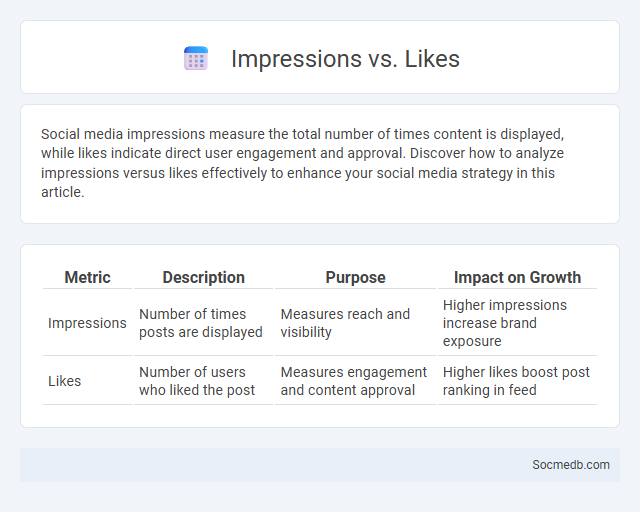
Photo illustration: Impressions vs Likes
Social media impressions measure the total number of times content is displayed, while likes indicate direct user engagement and approval. Discover how to analyze impressions versus likes effectively to enhance your social media strategy in this article.
Table of Comparison
| Metric | Description | Purpose | Impact on Growth |
|---|---|---|---|
| Impressions | Number of times posts are displayed | Measures reach and visibility | Higher impressions increase brand exposure |
| Likes | Number of users who liked the post | Measures engagement and content approval | Higher likes boost post ranking in feed |
Understanding Impressions: Definition and Importance
Impressions in social media refer to the total number of times content is displayed to users, highlighting the scope of audience exposure regardless of engagement. Tracking impressions provides critical insights into content reach, assisting marketers in evaluating brand visibility and campaign effectiveness. High impression counts indicate successful distribution strategies and potential for increased user interaction.
What Are Likes? Meaning and Social Media Impact
Likes on social media represent a form of user engagement signaling approval or interest in content such as posts, photos, or videos. These interactions significantly influence algorithm-driven visibility, boosting Your content reach and fostering community growth. Understanding the meaning and impact of likes helps in strategizing effective social media marketing and enhancing online presence.
Impressions vs Likes: Key Differences
Impressions measure how many times your social media content is displayed, indicating overall visibility, while likes represent the number of users who actively engage with your content by expressing approval. Understanding the key differences between impressions and likes helps you analyze both reach and engagement metrics effectively. Your marketing strategy benefits by focusing not only on visibility but also on the audience's interaction with your posts.
Measuring Content Success: Which Metric Matters More?
Engagement rate, including likes, comments, and shares, remains the most reliable metric for measuring social media content success because it directly reflects audience interaction and interest. Reach and impressions indicate how many people see the content, but high engagement signals deeper connection and potential influence. Conversion rate is crucial for understanding content effectiveness in driving specific actions like sales or sign-ups, making it essential for goal-oriented campaigns.
The Role of Impressions in Brand Awareness
Impressions on social media measure how often content is displayed, directly influencing brand visibility and recall among target audiences. High impression counts enhance the likelihood of brand recognition, making it crucial for businesses to optimize content timing and platform algorithms. Consistent and strategic impression management fosters stronger brand awareness, driving increased engagement and customer loyalty.
Why Likes Matter for Engagement
Likes serve as key indicators of user engagement on social media platforms by signaling content popularity and relevance to algorithms. High like counts increase content visibility, driving more organic reach and interaction from diverse audiences. Brands and influencers leverage likes to build credibility, attract followers, and optimize content strategies for stronger audience connections.
Interpreting Analytics: Impressions vs Likes Strategies
Interpreting social media analytics requires understanding the distinction between impressions and likes, as impressions measure total content views while likes indicate active user engagement. An effective strategy prioritizes increasing impressions for broader brand awareness and leverages likes to gauge content resonance and audience preferences. Analyzing these metrics together informs content optimization and targeted marketing campaigns for improved social media performance.
Boosting Impressions vs Increasing Likes
Boosting impressions on social media enhances brand visibility by exposing content to a larger audience, increasing the chances of organic engagement and follower growth. Increasing likes focuses more on user interaction and content approval, signaling relevance and quality to algorithms that prioritize engagement. Balancing both strategies optimizes social media performance by combining reach with active audience involvement.
Common Misconceptions: Impressions and Likes Explained
Impressions on social media represent the total number of times your content is displayed, regardless of user interaction, while likes indicate direct engagement from users who appreciate your post. Many mistakenly equate high impressions with guaranteed popularity, overlooking that impressions do not measure active interest or conversions. Understanding the distinction helps you accurately assess campaign performance and optimize strategies for genuine user engagement.
Choosing the Right Metric for Your Social Media Goals
Selecting the right metric for your social media goals depends on the specific objectives of your campaign, such as brand awareness, engagement, or conversion. Metrics like reach and impressions are ideal for measuring visibility, while engagement rate and shares provide insight into audience interaction. For sales-driven goals, tracking click-through rates and conversion rates offers a clear indication of campaign effectiveness.
 socmedb.com
socmedb.com